

Dedicated to Nicole, my crafting partner in crime.
Copyright Copyright 2019 by Cari Buziak All rights reserved.
Bibliographical NoteWhimsical Cross-Stitch: More Than 130 Designs from Trendy to Traditional is a new work, first published by Dover Publications, Inc., in 2019. The author wishes to thank Ursa Software specifically for the MacStitch computer program, which was used to generate the designs for this book, and most especially for their extraordinary customer service.
Library of Congress Cataloging-in-Publication Data Names: Buziak, Cari, author. Title: Whimsical cross-stitch : more than 130 designs from trendy to traditional / Cari Buziak.
Description: Mineola, New York : Dover Publications, Inc., [2019] Identifiers: LCCN 2018054000 | ISBN 9780486828626 | ISBN 048682862X Subjects: LCSH: Cross-stitchPatterns. Classification: LCC TT778.C76 B89 2019 | DDC 746.44/3dc23 LC record available at https://lccn.loc.gov/2018054000 Manufactured in the United States by LSC Communications 82862X01 2019 www.doverpublications.com CONTENTS SUPPLIES Cloth Types Aida cloth is the easiest cloth to begin your cross-stitch adventures with, because the small Xs in the fabric make it easy to see where your stitches will go. Evenweave cloth and Luganda cloth have a very even weave but without the square appearance, so they are nice for intermediate to advanced projects, as they have a more polished final look. Any of these fabrics can be found in an array of colors.
Note: All pattern sizes in this book are based on 14 count Aida cloth.  Aida Cloth
Aida Cloth Evenweave or Luganda ClothNeedles A tapestry needle is used for cross-stitching because it has a larger eye for easy threading as well as a blunt tip, which finds its way between the threads of your fabric easily. Embroidery Floss and Backstitching All charts in this book use the brand DMC for color floss and use two strands of thread. Embroidery Floss and Backstitching All charts in this book use the brand DMC for color floss and use two strands of thread.
Evenweave or Luganda ClothNeedles A tapestry needle is used for cross-stitching because it has a larger eye for easy threading as well as a blunt tip, which finds its way between the threads of your fabric easily. Embroidery Floss and Backstitching All charts in this book use the brand DMC for color floss and use two strands of thread. Embroidery Floss and Backstitching All charts in this book use the brand DMC for color floss and use two strands of thread.
If you are stitching on a darker fabric, consider using three strands so the design stands out more. Not all the charts in this book have backstitching; however those that do will have a colored bar added by the thread color that should be used for the backstitching. Backstitching is always done last, after the rest of the chart has been stitched. It is used to define color areas and edges and can be done in one or two strands of thread. For backstitched lettering, two strands or even three are recommended for readability. Step 1: Come up through hole 1. Step 1: Come up through hole 1.
Go down through hole 2.Step 2: Come up through hole 3. Go down through hole 1. Aida Cloth
Aida Cloth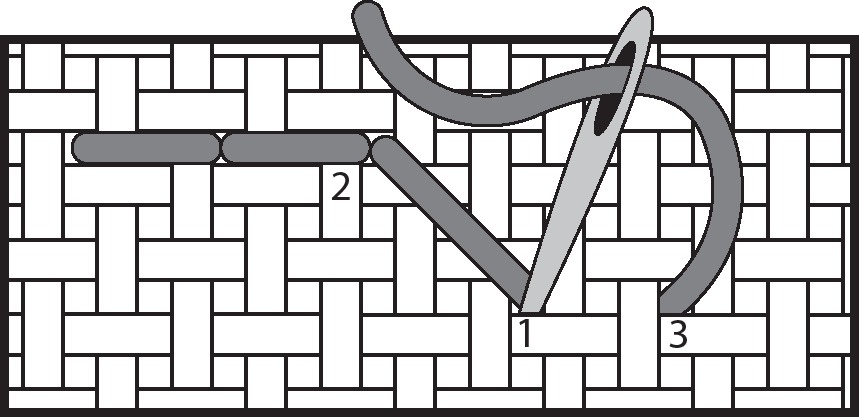 Evenweave Cloth SETTING UP What Is Thread Count? Thread count refers to the number of stitches per inch for a project. Aida fabric, being made up of tiny squares (one square is a stitch) comes in some common thread counts: 11 count, 14 count, and 16 count. So comparing 16 count and 11 count, for example, in 16 count each stitch will be tinier than 11 count, because youre packing more stitches within that inch. The projects in this book are 14 count (and therefore will give you the finished design sizes estimated for each project), but you can easily stitch them on 11 or 16 count fabric if you choose. 16 count will be finer and give a more detailed look to your design, but the finished design will be smaller than whats estimated. 16 count will be finer and give a more detailed look to your design, but the finished design will be smaller than whats estimated.
Evenweave Cloth SETTING UP What Is Thread Count? Thread count refers to the number of stitches per inch for a project. Aida fabric, being made up of tiny squares (one square is a stitch) comes in some common thread counts: 11 count, 14 count, and 16 count. So comparing 16 count and 11 count, for example, in 16 count each stitch will be tinier than 11 count, because youre packing more stitches within that inch. The projects in this book are 14 count (and therefore will give you the finished design sizes estimated for each project), but you can easily stitch them on 11 or 16 count fabric if you choose. 16 count will be finer and give a more detailed look to your design, but the finished design will be smaller than whats estimated. 16 count will be finer and give a more detailed look to your design, but the finished design will be smaller than whats estimated.
When selecting or cutting your fabric to begin stitching, make sure to add a few extra inches around it for framing and hooping, 4 at least. An extra 4 to the height and width listed for your chart design will give you 2 around your design on all sides. Remember you can always trim any extra off after, but you cant add any back on! So if youre not sure, err on the side of caution, especially if you havent decided how youll be displaying or framing your design when its finished. All charts have darker grid lines every 10 squares, to help you find your way in the pattern. The horizontal and vertical center lines have also been marked for you. A good rule of thumb is to photocopy a chart before you begin, and then you can color in the squares as you stitch and keep track of where you are as you go.
When photocopying, use the opportunity to enlarge the chart so that the symbols are easily readable. Its not uncommon to use a magnifying bar or glass to read cross-stitching charts; visit your local retail store for different options. Finding the Center To make sure that your image is positioned correctly on your cloth, youll need to find both the center of the fabric and the center of your chart. Use the horizontal and vertical arrows to find where they intersectthis is the chart center. Fold your fabric into quarters (top to bottom and then side to side). The folded corner is the center of your fabric.
You may wish to stitch a small X there in bright thread or mark it with a pin. To begin stitching, count from the center of your chart to where you want to begin (e.g., four squares up and ten to the left) and find the corresponding place by counting squares on your fabric. Starting and Finishing Stitching Cross-stitch does not use knots to fasten the ends of the threads. To fasten the ends of thread, leave about a one-inch tail of thread when you pull your needle through for your first stitch. Come up from the bottom, leaving your 1-inch tail behind, and then go back down through the front of the fabric in the appropriate hole (see for making the stitches). When you come back up to start the other half of that first stitch, make sure that the loop in the back catches the tail, so that when pulled tight the tail is secured.
After a few stitches like this, the tail should be snugly held in place and any excess tail can be trimmed neatly. When your thread gets down to about 3 inches or so, youll want to fasten it off and begin a new piece of thread. So at the end of your last stitch, turn the work over and use your needle to weave the remaining thread through the backs of six or seven stitches, until it looks secure. Trim the end. STITCHING Single Stitch To cross-stitch on either Aida or Evenweave cloth, you will need to create an X by going through the holes of the fabric in a particular order. The diagrams below show how this will look on both types of fabric.
When stitching on Evenweave cloth, its common to stitch over two strands of thread. Using your threaded needle, stitch your first stitch like this:


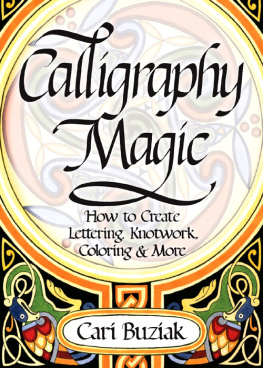
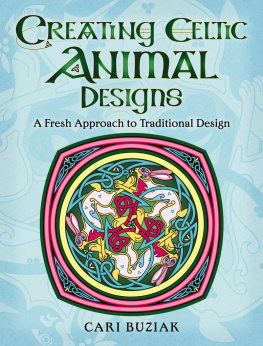
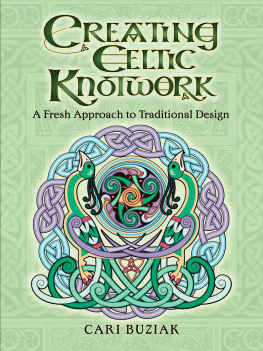

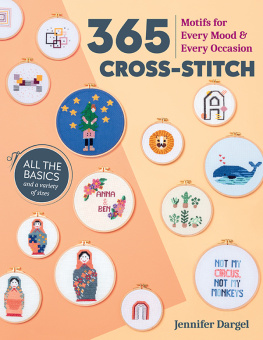

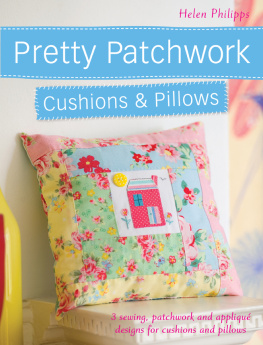
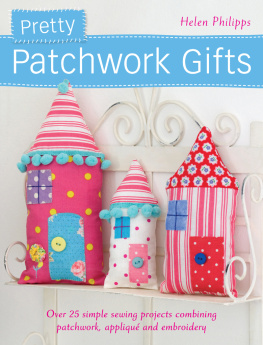

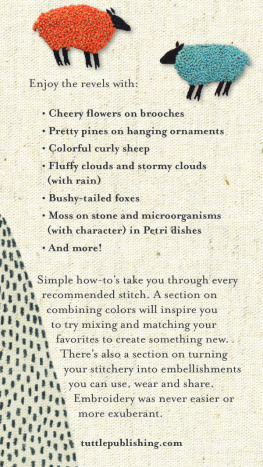
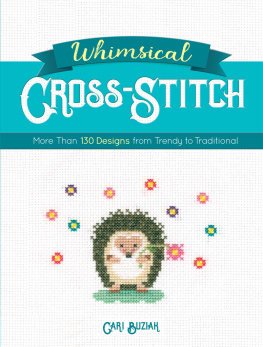


 Dedicated to Nicole, my crafting partner in crime. Copyright Copyright 2019 by Cari Buziak All rights reserved. Bibliographical NoteWhimsical Cross-Stitch: More Than 130 Designs from Trendy to Traditional is a new work, first published by Dover Publications, Inc., in 2019. The author wishes to thank Ursa Software specifically for the MacStitch computer program, which was used to generate the designs for this book, and most especially for their extraordinary customer service. Library of Congress Cataloging-in-Publication Data Names: Buziak, Cari, author. Title: Whimsical cross-stitch : more than 130 designs from trendy to traditional / Cari Buziak.
Dedicated to Nicole, my crafting partner in crime. Copyright Copyright 2019 by Cari Buziak All rights reserved. Bibliographical NoteWhimsical Cross-Stitch: More Than 130 Designs from Trendy to Traditional is a new work, first published by Dover Publications, Inc., in 2019. The author wishes to thank Ursa Software specifically for the MacStitch computer program, which was used to generate the designs for this book, and most especially for their extraordinary customer service. Library of Congress Cataloging-in-Publication Data Names: Buziak, Cari, author. Title: Whimsical cross-stitch : more than 130 designs from trendy to traditional / Cari Buziak.  Aida Cloth
Aida Cloth Evenweave or Luganda ClothNeedles A tapestry needle is used for cross-stitching because it has a larger eye for easy threading as well as a blunt tip, which finds its way between the threads of your fabric easily. Embroidery Floss and Backstitching All charts in this book use the brand DMC for color floss and use two strands of thread. Embroidery Floss and Backstitching All charts in this book use the brand DMC for color floss and use two strands of thread.
Evenweave or Luganda ClothNeedles A tapestry needle is used for cross-stitching because it has a larger eye for easy threading as well as a blunt tip, which finds its way between the threads of your fabric easily. Embroidery Floss and Backstitching All charts in this book use the brand DMC for color floss and use two strands of thread. Embroidery Floss and Backstitching All charts in this book use the brand DMC for color floss and use two strands of thread. Aida Cloth
Aida Cloth Evenweave Cloth SETTING UP What Is Thread Count? Thread count refers to the number of stitches per inch for a project. Aida fabric, being made up of tiny squares (one square is a stitch) comes in some common thread counts: 11 count, 14 count, and 16 count. So comparing 16 count and 11 count, for example, in 16 count each stitch will be tinier than 11 count, because youre packing more stitches within that inch. The projects in this book are 14 count (and therefore will give you the finished design sizes estimated for each project), but you can easily stitch them on 11 or 16 count fabric if you choose. 16 count will be finer and give a more detailed look to your design, but the finished design will be smaller than whats estimated. 16 count will be finer and give a more detailed look to your design, but the finished design will be smaller than whats estimated.
Evenweave Cloth SETTING UP What Is Thread Count? Thread count refers to the number of stitches per inch for a project. Aida fabric, being made up of tiny squares (one square is a stitch) comes in some common thread counts: 11 count, 14 count, and 16 count. So comparing 16 count and 11 count, for example, in 16 count each stitch will be tinier than 11 count, because youre packing more stitches within that inch. The projects in this book are 14 count (and therefore will give you the finished design sizes estimated for each project), but you can easily stitch them on 11 or 16 count fabric if you choose. 16 count will be finer and give a more detailed look to your design, but the finished design will be smaller than whats estimated. 16 count will be finer and give a more detailed look to your design, but the finished design will be smaller than whats estimated.